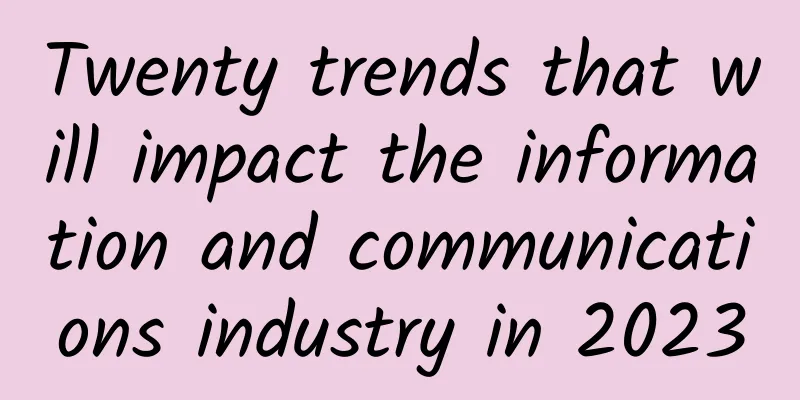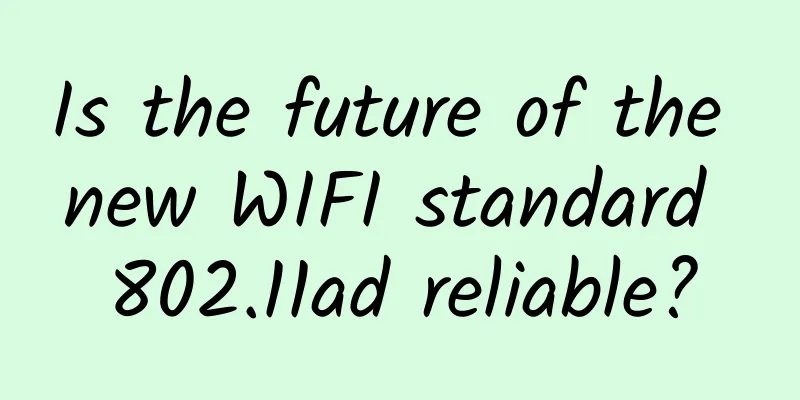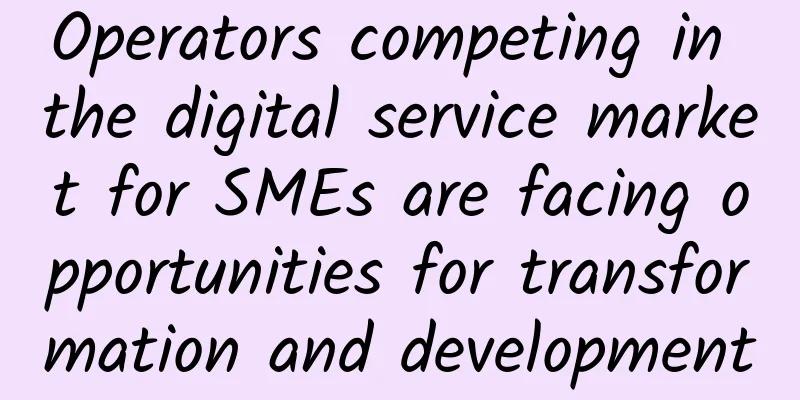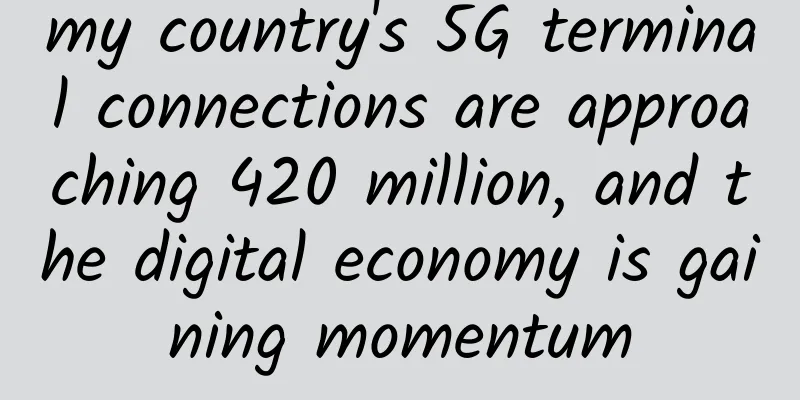Twenty trends that will impact the information and communications industry in 2023

|
Attack and start again! As we bid farewell to the old and usher in the new, it is time to explore the future development. 2023 is a critical year for the "14th Five-Year Plan". Which technological trends will lead industrial development? Which industrial trends will affect the direction of the industry? Communication World Omnimedia launched the 2023 Information and Communication Industry Trend Outlook, discussing the industry trend and seeking market opportunities, to help the development of the ICT industry in 2023. Trend 1: The digital economy accelerates the release of potential and enables the integrated development of the real economyWith the gradual deepening of social digital transformation, my country's digital economy development has achieved reasonable growth in quantity and effective improvement in quality, and has accelerated its transition to a new stage of deepening application, standardized development, and universal sharing. The digital economy has also transformed from a component of the economy to a leading force for economic development. It is estimated that by 2023, the scale of my country's digital economy will exceed 52 trillion yuan, the development of industrial digitalization will enter an accelerated track, and the results of digital transformation in various industries will become more apparent. Digital technologies such as 5G, cloud computing, artificial intelligence, and the metaverse can realize the integration of the digital world and the real world, realize innovation-driven development through digital technologies, and promote economic development and industrial structure optimization through industrial digitalization, which will play a key role in empowering thousands of industries in 2023. The above-mentioned digital technologies are in a major transformation period led by system innovation and intelligence. The new generation of information technology accelerates integrated innovation and industrial deployment, and subversive, cutting-edge, and integrated new products have emerged one after another. Competition in the field of digital core technologies will become more intense. Trend 2: 5G enters a mature stage, and large-scale development is expected to break throughIn 2022, the construction speed of global 5G networks continued to accelerate. As of the end of November 2022, 237 operators in 90 countries and regions around the world have announced the provision of 5G services. China has opened a total of 2.28 million 5G base stations, and all urban areas of prefecture-level cities have achieved coverage. my country's 5G industry applications have entered a critical period of large-scale development. 5G is playing an enabling role in multiple industries such as industry, medical care, education, and transportation, forming multiple typical application scenarios with commercial value, covering 40 of the 97 major categories of the national economy, and 5G application cases have accumulated more than 20,000. In 2023, the expansion of 5G industry applications still faces three major challenges, namely value, cost and integration. At present, the value of 5G applications has not been fully utilized and needs to be further explored; the application of key industries has entered the growth stage and needs to accelerate the scale development; the integration of 5G and the industry still faces some challenges, and now it is necessary to promote the mature cases from benchmark enterprises to the entire industry. In the future, the development of 5G will also need to expand the breadth of the industry, deepen the business depth, strengthen the construction of cross-industry integration standard system, and build an industry-oriented 5G integration product system. Trend 3: 5G private network market is expected to accelerate growth, and license issuance may be the key5G private networks are an indispensable means for vertical industries to promote 5G application innovation, expand production efficiency, and accelerate digital transformation. With the joint efforts of all parties in the industry, 5G private network equipment has basically matured and has been fully applied. The number of 5G industry virtual private networks has exceeded 10,000. 5G applications have covered 40 major categories of the national economy and have been gradually promoted in multiple fields such as industry, medical care, education, and transportation. Looking ahead to 2023, 5G application areas will further expand from basic connections and peripheral auxiliary links to production center links. With the implementation of supporting policies, the number of 5G demonstration projects will maintain high growth in 2023. The 5G private network ecosystem led by operators and participated by multiple entities will be further improved. In 2022, the Ministry of Industry and Information Technology officially announced that COMAC has obtained the country's first frequency license for enterprise 5G private networks, which will be used for 5G connections in its factories, enabling enterprises to grasp resources and deploy their own networks. With the increasing effectiveness of construction, this will further enhance users' recognition of "5G+Industrial Internet", making it possible to issue more 5G private network frequency licenses to industry leaders in the future, and the scale of the 5G private network market is expected to accelerate. Trend 4: Accelerating the construction of digital foundation, Gigabit optical network promotes economic developmentAt present, my country has built the world's largest fixed broadband network, and all cities at or above the prefecture level in the country have achieved full coverage of fiber optic networks. Gigabit optical networks build a digital smart foundation. By the end of 2022, a total of 110 cities in the country will meet the gigabit city construction standards, accounting for about one-third of all prefecture-level cities. The development of gigabit smart homes starts with the evolution of the network foundation. In terms of technology, gigabit optical networks are evolving from F5G to F5G-A, continuously improving the performance of enhanced broadband, all-optical connection, and experience assurance, and adding three new network features: green agility, visual perception, and reliable determination. FTTR is an important technical evolution direction for the gigabit optical network capacity base to extend further to the user side and achieve seamless gigabit coverage on the user side. In 2023, the industry will work together to accelerate the convergence and standardization of architecture and key technical solutions. Promoting application innovation and penetration empowerment is the focus of the future development of Gigabit optical networks. At present, the application solutions of Gigabit optical network technology have achieved good results in some application scenarios. In the future, more Gigabit optical network application technology solutions will be promoted in the industry to form a mature business model. FTTR is the top priority for operators to expand smart home business. As home users pay more and more attention to security issues, smart security has become a new blue ocean for operators, and smart home business is also advancing towards scenario-based, intelligent, and differentiated services. The integration of digital technology and biotechnology also brings new development opportunities for the expansion of Gigabit Smart Home business models. Trend 5: National standards for the industrial Internet are expected to be released one after another, and industrial development will enter a new stageIn 2023, the "Industrial Internet Innovation and Development Action Plan (2021-2023)" will enter its final year. It can be foreseen that by the end of 2023, the new infrastructure of the industrial Internet will be further improved, the results of integrated applications will be further demonstrated, the technological innovation capabilities will be further enhanced, the industrial development ecosystem will be further improved, and the security assurance capabilities will be further enhanced. The construction of the new infrastructure of the industrial Internet will advance both in quantity and quality, new models and new formats will be widely promoted, and the comprehensive strength of the industry will be significantly improved. At the same time, with the release of three national standards in 2022, it is expected that more national standards will be released in the fields of industrial Internet networks, platforms, and security in 2023 to further improve the standard system. However, as my country's industrial Internet development enters a new stage, the number of devices connected to the Internet and enterprises going to the cloud is increasing, and security risks are increasing, which puts higher requirements on network security work. The security of the industrial Internet is still facing problems such as low network security awareness of industrial enterprises, insufficient technical protection capabilities, weak security monitoring capabilities, and insufficient support from the network security industry. The situation of industrial Internet security issues may become more severe. Trend 6: 5G continues to evolve towards cloud-network integration and computing-network integrationToday, 5.5G has started the process of standardization. 3GPP will define 5.5G technical specifications through R18, R19, and R20 versions, and continue to enrich the technical content of 5.5G. With the establishment of the first batch of R18 projects, 5.5G technology research and standardization have entered a substantive stage, and it has been established that R18 will continue to enhance eMBB, and it is expected to achieve the goal of a tenfold increase in capabilities. In the future, R19 and R20 versions will continue to enhance new services and new scenarios. Artificial intelligence, full-duplex, green energy-saving networks, XR, 5G Internet of Things for wearable devices, 5G satellite communications, 5G Internet of Vehicles, direct communication, and enhanced broadband services for smart terminals will continue to evolve in subsequent standard specifications. At the architectural level, 5.5G networks will fully consider cloud native, edge networks, mobile computing power perception and scheduling, and the concept of "network as a service", continue to enhance network capabilities, and ultimately move towards cloud-network integration and computing-network integration. Trend 7: 6G original technology research is accelerating, and satellite Internet and ground cellular systems are moving towards integrationmy country's original 6G technology research is constantly advancing, and industry, academia and research are accelerating the transformation of results. At present, the new generation of information technology represented by 6G has become the focus of global innovation. my country's IMT-2030 Promotion Group has launched the test of 6G prototype system, including terahertz communication, interawareness integration, intelligent metasurface, distributed autonomous network and computing power network, to promote the in-depth and practical development of 6G research and development. The top-level design and end-to-end technical system of 6G have been initially formed, and the vision and demand for 6G proposed by my country have also been widely recognized by the industry. In 2023, my country will actively carry out original technology research in areas with significant impact and active innovation, such as 6G, computing network, satellite Internet, next-generation artificial intelligence, metaverse and quantum information, and build large-scale information and communication technology innovation test devices such as 6G test system, computing network test network, network intelligence open innovation platform, etc., to help industry-university-research collaborative innovation and accelerate the transformation of results. The key technology of 6G satellite-ground integration will realize the organic integration of satellite and ground cellular communications. In 2023, the industry will gradually carry out ground testing and satellite-ground joint testing. Trend 8: Computing power network leverages the power of Qingyun, and computing power sharing will benefit more industriesWith the deepening cultivation and accelerated promotion of the concept of computing power network, the industry consensus of "using the network to strengthen computing and using computing to promote the network" has been deeply rooted in the hearts of the people. At this stage, "computing power network" is no longer limited to computing power in a narrow sense, but a new type of productivity that integrates "computing power, storage power, and transportation power". In February 2022, the "East Data West Computing" project was fully launched, injecting the strongest impetus into the development of my country's computing power network. The construction of computing power infrastructure will drive the rapid growth of the computing power industry, and the scale of my country's computing power industry will continue to grow. Guided by the "East Data and West Computing", in 2023, as the deployment of related industries gradually deepens, computing power sharing will benefit all walks of life, and the networking of computing power infrastructure will make substantial progress; the increasingly strong demand will drive the further expansion of computing power. It is estimated that by the end of 2023, the total computing power of data centers across the country will exceed 200EFLOPS; the advantages of intelligent computing power are highlighted. It is predicted that intelligent computing power will account for 70%~80% of the new computing power in the future; edge computing will be accelerated following the construction of 5G and industrial Internet. Looking at industry applications, the industrial intelligent computing network of "5G+edge computing" will usher in the starting stage. Trend 9: Achieving independent innovation, safety and controllability, and the “national cloud” continues to advance rapidlyThe current development of domestic cloud computing is affected by the changes in the domestic and international competition situation. Self-control and data security have been raised to an unprecedented level, and the industrial structure has undergone tremendous changes. With the advantages of self-control, security and trustworthiness, the "national cloud" represented by Tianyi Cloud has achieved rapid growth in market share in recent years. Tianyi Cloud has ranked second in the public cloud IaaS market share for four consecutive years. At present, the "National Cloud" is mainly led by operators and participated by central enterprises. The voice of Internet vendors in the field of government and enterprise services may face challenges, especially in the context of strengthening data security and privacy protection in China. If the "National Cloud" becomes a sample promoted by local governments, it will indeed create a certain amount of pressure in the short term for leading cloud service vendors that provide "overall solutions". In 2023, the "National Cloud", with its advantages of "autonomy and controllability, security and reliability, inclusive services, cloud-based digital intelligence, green and low-carbon, and open ecology", will continue to coordinate scientific and technological innovation, facility construction, and security protection system deployment to serve the overall development of my country's digital economy. Trend 10: The value of the IoT industry will further increase, and the market value of health equipment is expected to grow rapidlyIn 2022, my country became the first country among the world's major economies to achieve "Internet of Things Superman". As of the end of November 2022, the three major basic telecommunications companies have developed 1.818 billion cellular Internet of Things terminal users, which has exceeded the number of mobile phone users by 134 million, accounting for 51.9% of the number of mobile network terminal connections. At the same time, it should also be noted that the Internet of Things platform market continues to "reshuffle". In the second half of 2022, corporate giants such as Google, Bosch, IBM, and Ericsson successively announced the closure or sale of their Internet of Things platforms, and the low platform value and lack of scale effect were the main reasons for their withdrawal. In 2023, it is expected that there will be more than 43 billion devices connected to the Internet of Things worldwide, which will generate, share, collect data, and help people use data in various ways. Two very important technologies, digital twins and metaverse, will be integrated to better promote the development of the industry. IoT security is also highly valued. The number of IoT devices will explode after 2023. Enterprises, equipment manufacturers and security experts should strengthen cooperation to deal with "malicious attackers" and minimize their chances of stealing valuable data. In 2023, the market value of IoT health devices will grow rapidly, and IoT governance and regulation will be given more attention. The European Union is expected to introduce laws requiring smart device manufacturers and operators to comply with stricter rules, including how to collect data, store data, and protect data security, etc., which is only part of a series of new regulations implemented around the world. Trend 11: Internet giants are focusing on industrial Internet, and the integration of digital and real industries is giving birth to new industrial formatsAs the consumer Internet enters a growth "bottleneck period", the Internet industry's to C stock market has become saturated, and new breakthroughs are needed to continue to develop. Internet giants are competing to develop to B fields, taking the digital transformation of the real economy as a starting point, and elevating the integration of digital and real to an unprecedented strategic height. The integration of data and the real is the key to the digital economy. Today, Internet giants are following the trend and deepening their digital and real sectors, organically integrating the technological accumulation of the consumer Internet era with traditional enterprises. The value insights and driving capabilities brought by data, and the widely existing agile capabilities built with cloud as the core, the two are superimposed to build digital cloud integration capabilities, which will become a new value growth engine for enterprises to promote "business digitalization and digital business". In 2023, the Internet industry will most likely end its negative growth, and major companies will "shift from virtual to real", further develop the field of industrial Internet, organically integrate the technological accumulation of the consumer Internet era with traditional enterprises, and promote data and technological elements to inject new impetus into the real economy, help traditional industries transform and upgrade, and give birth to new industries and new formats. Trend 12: Metaverse “enters the homes of ordinary people”, and digital humans may become standard equipment for enterprisesAfter the "explosion" in the first two years, the Metaverse entered a relatively pragmatic stage in 2022. With the holding of events such as the Winter Olympics, Metaverse applications have shown their unique charm. Virtual digital people have made their debuts, the 2022 Beijing Fair for Trade in Services will debut a Metaverse Pavilion, and the Metaverse Innovation and Development Plan will be released one after another... In 2022, the Metaverse continued to appear in the context of the Internet, and phased progress has been made in consumer hardware, content ecology, and infrastructure. 2023 is a key year for the Metaverse industry. As the door to industry applications gradually opens, companies will go all out to seize the high ground of the virtual world in 2023, promote the clever "marriage" of the Metaverse and "digital twins", accelerate the integration and development of new AI technologies and virtual reality interaction capabilities, and are expected to promote Metaverse to achieve multiple breakthroughs in digital humans, 3D rendering and other applications. Guided by user needs, Metaverse is expected to usher in an explosive period of application in e-commerce, finance, medical care, education, government affairs and other fields; guided by actual value, Metaverse industrial applications will receive more and more attention from the industry. Trend 13: The “Second Curve” has taken a step forward, and digital services have become the key focus of the three major operatorsIn the first half of 2022, thanks to the rapid expansion of emerging businesses such as cloud computing, data centers, and computing networks, the three major operators have made great efforts in the digital economy, and the "second curve" has performed impressively. China Telecom's industrial digital business revenue reached 58.9 billion yuan, accounting for nearly 50% of the incremental revenue; China Mobile's digital transformation revenue reached 110.8 billion yuan, becoming the main driving force for China Mobile's revenue growth; China Unicom's industrial Internet achieved revenue of 36.9 billion yuan, contributing 72% of the new revenue, becoming the "first engine" of performance growth. In 2023, the three major operators will make great strides in digital business around industrial digitalization, digital industrialization, and digital intelligence represented by artificial intelligence. They will further develop their own distinctive businesses and explore the endogenous driving force of digital transformation to drive revenue growth. Taking 5G, cloud computing and other technologies as the starting point and making good use of the advantages of leading layout, the three major operators will focus on expanding application scenarios, and are committed to providing integrated solutions from terminals to networks, from clouds to software services, and uniting upstream and downstream industries to jointly build a new information service system in the digital economy era. Trend 14: “Rise” or “Fall”: 2023 will be a critical period for the development of radio and televisionAfter obtaining the 5G license, China Radio and Television has achieved important results in 5G network construction and enabling industry applications. As of September 2022, all 31 provinces (autonomous regions and municipalities) in the country, except Hong Kong, Macao and Taiwan, have opened radio and television 5G network services, marking a new breakthrough in the integration of China Radio and Television's national cable TV network and the integrated development of radio and television 5G construction. China Radio and Television and China Mobile are actively promoting the co-construction and sharing of 5G networks, focusing on building a 700MHz5G network. The two parties have currently co-built and shared 850,000 5G base stations. At present, China Radio and Television's 192 number users have exceeded 5 million, and there are more than 500 5G mobile phones that support the 700MHz frequency band. 2023 will be a critical period for the "rise" or "fall" of China Radio and Television. The other three operators are all going further and further on the road of digitalization, promoting the large-scale implementation of 5G empowerment in thousands of industries. As the fourth largest operator, China Radio and Television still has a long way to go in enabling the digital transformation of the industry. At present, China Radio and Television still needs to expand its users in the to C business, and further expand and enrich the industry application scenarios of 5G in the to B field. In the future, China Radio and Television will also need to find 5G applications that are more in line with its own positioning, continue to deepen its presence in mining, elderly care, education, government affairs, industrial Internet, emergency broadcasting, smart border consolidation and other fields, give full play to the advantages of cultural digitization and the technical capabilities of the 700MHz golden frequency band, and serve thousands of households and industries with high-efficiency 5G networks. Trend 15: Mobile resale celebrates its 10th anniversary, with virtual operators entering the “new track” of IoT resaleOver the past decade, virtual operators have gone through a process from pilot to formal operation, and then to full business rollout. Although highly anticipated, it has not changed the industry landscape. As of the end of June 2022, the scale of mobile resale users was 80.07 million, a decrease of 10.11 million from the end of 2021, and the cumulative revenue of the mobile resale industry was 2.07 billion yuan, a year-on-year increase of 16.9%; but the number of companies with positive revenue growth was 22, 7 fewer than in 2021. Compared with the more than one billion users and tens of billions of yuan in revenue of the three major basic telecommunications operators, this is insignificant, and the determining factors of the communications industry landscape are still in the hands of telecommunications operators. The Internet of Things has always been considered a "new way out" for virtual operators. In early 2023, the first IoT resale license was officially issued, and mobile resale companies officially entered the "new track" of IoT resale. It is believed that more and more virtual operators will obtain IoT resale licenses. In this era of "things over people", the number of IoT connections may reach hundreds of billions, and there is huge room for growth in the IoT resale business. However, the communication cost of a single IoT device is much lower than that of a mobile phone user, but the incremental value space provided to users around the connection is huge. If virtual operators can provide good connection services around the resale business, they can obtain greater benefits. Trend 16: The smartphone market continues to be sluggish, but is expected to recover in the second half of the yearThe smartphone market is sluggish in 2022. Data shows that global smartphone shipments fell 8.88% year-on-year from January to September, and domestic smartphone shipments fell 21.1% year-on-year. Affected by this, mainstream mobile phone manufacturers such as vivo, OPPO, and Xiaomi all showed negative growth, adjusted their inventories, and continued to explore new growth points, hoping to achieve counter-trend growth by impacting the high-end, entering the folding screen, self-developed chips, and focusing on smart connected cars. It is expected that the sluggish development of the terminal industry will continue until 2023, smartphone shipments will continue to decline, the replacement cycle will continue to lengthen, and the phenomenon of smartphone homogeneity will continue. However, with the decline in supply chain prices, the growth of market share of high-end and foldable phones, and the continuous upgrading of mobile phone imaging and gaming experience, the decline in China's mobile phone market will narrow next year, which is also the source of confidence for Xiaomi, OPPO, vivo and other manufacturers to continue moving forward. It is expected that the entire mobile phone industry will recover in the second half of this year. Trend 17: Huawei's overall business has stopped falling, but Huawei's mobile phone business is uncertain2022 is the year when Huawei gradually turns from the "wartime state" of dealing with the continuous sanctions from the United States to safety. This year, Huawei's business as a whole stops falling, the new growth momentum effect is prominent, the ICT infrastructure business maintains stable growth, the digital energy and Huawei Cloud businesses grow rapidly, and the competitiveness of smart car components and user experience are significantly improved. However, it is undeniable that the inability to mass produce HiSilicon chips has caused a sharp decline in the competitiveness of Huawei's mobile phones, and shipments have continued to decline, and Huawei's terminal business is still declining. With the inventory of HiSilicon chips "returning to zero", the industry has predicted that Huawei may sell its mobile phone business line in 2023 to reduce losses. 2023 is a critical year for Huawei to maintain normal operations under the normalization of sanctions. Huawei will seize the development opportunities of digitalization and low carbonization, optimize the resource allocation of 5G, intelligent connected vehicles, cloud and other businesses, give full play to the advantages of industrial portfolio, and achieve high-quality growth. ICT infrastructure business should be proactive and seize the opportunities of digital transformation in all walks of life to achieve effective growth; Huawei Cloud should become the foundation and enabler of digitalization in all walks of life; digital energy should dare to invest in strategic opportunity windows, enhance product competitiveness, and effectively manage the uncertainty risks of global commodity supply; the smart car parts business should focus on key incremental parts and strive to achieve commercial scale. Trend 18: The chip industry may face a greater decline, and companies are optimizing their production capacity layout2022 is a year of turning point for the development of the semiconductor industry. On the one hand, terminal demand is weak, and the semiconductor industry, which is mainly based on consumer electronics, has entered a downward cycle; on the other hand, the demand for chips in 5G, automobiles, data centers, industry and other fields has increased, and the conversion of new and old kinetic energy in the chip industry has accelerated. Chip companies have optimized their product portfolios, adjusted their production capacity layout, and exerted their strength in multiple "tracks" to resist market risks and seek long-term growth. The development trend of the semiconductor industry in 2023 is still not optimistic. Gartner predicts that the revenue of chip companies will drop by 3.6% in 2023, and the global capital expenditure of semiconductors will face the largest decline since 2008. However, by then, chip manufacturers may find a balance in products, production capacity, and strategy, and can fully cope with market risks; coupled with the innovation of 5G, autonomous driving, metaverse and other fields, as well as the recovery of new consumer electronics such as folding screens, the long-term trend of increasing demand and upgrading in the semiconductor industry is foreseeable. It is expected that the market situation of the semiconductor industry will gradually improve in 2023. Trend 19: Enterprises accelerate their layout, and intelligent connected vehicles usher in a period of rapid developmentIn 2022, with the joint efforts of all aspects of the industry, my country has formed a relatively complete technology chain for intelligent connected vehicles. Breakthroughs have been made in the independent research and development of key technologies such as autonomous driving system integration, lidar, control decision-making, algorithms, AI chips, smart cockpits, CV2X, and Beidou positioning. China has formed a trend of running side by side with global leading manufacturers. Some products have been applied in front-end mass production, which has strongly supported the development of my country's intelligent connected vehicles. With the booming development of the intelligent connected car industry, more and more companies are entering the market. For example, terminal manufacturers Xiaomi and Apple have increased their investment in car manufacturing, OPPO has focused on car-machine interconnection, Huawei has launched a series of intelligent car solutions, chip manufacturer Qualcomm has launched cockpit chips and digital chassis, and ARM continues to promote innovation in automotive smart chips... In 2023, technological developments in the fields of electric, connected, and intelligent will continue to profoundly shape the automotive industry and stimulate consumer demand. It is expected that the annual compound growth rate of intelligent connected car shipments will be 16.8% in the next five years, and the intelligent connected car market will usher in rapid development. Trend 20: Data security is more valued, and data governance measures will continue to improveData resources are the driving force for the high-quality development of the digital economy. With the continuous development of technologies and industries such as the Internet, 5G, artificial intelligence, the Internet of Things, and the Industrial Internet, the amount of data in my country continues to show explosive growth. At present, the scale of my country's big data industry has exceeded one trillion yuan. The compliant and efficient circulation and use of data resources can fully stimulate the potential of data elements, empower the real economy, and comprehensively promote the strengthening and optimization of the digital economy. In 2023, my country will pay more attention to the use and governance of data elements, further accelerate the process of data legislation and the improvement of supporting measures, and promote the effective circulation and development and utilization of data. As a unified infrastructure for the collection, integration, sharing, and openness of public data, the construction of a national integrated government big data system will continue to accelerate. In view of the current situation of obvious gaps in the quantity, quality, and scope of data openness in various provinces, as well as data application scenarios, application quality, and diversity, in 2023, the standardized use of data elements will be anchored from the aspects of system, platform, and application to promote the circulation and development and utilization of data to the greatest extent. |
<<: RabbitMQ communication model publish-subscribe model
Recommend
CFCA creates a secure all-in-one solution, Kunpeng comprehensively promotes financial innovation
Currently, the financial industry is in a critica...
The Ministry of Industry and Information Technology reminds you to set the SIM card password in time. Doing these four things after losing your phone is more important than calling the police.
[[347353]] If you lose your phone, do you know wh...
VMISS 30% off, starting from $2.6/month, Hong Kong/Japan/Korea/Los Angeles CN2 GIA/AS9929/CMIN2 and other computer rooms
VMISS (Virtual Machines Innovative Solutions) was...
Aruba Helps Home Depot Reinvigorate Its Network to Improve Customer and Employee Experience
Aruba, a subsidiary of Hewlett Packard Enterprise...
What security risks may cause the Internet speed to suddenly slow down?
[[434023]] This article is reprinted from the WeC...
Driving industrial transformation in the intelligent era, Huawei Intelligent Computing 2019 is ready to go!
[51CTO.com original article] The first time the r...
edgeNAT VPS 30% off monthly payment, 40% off annual payment, deposit 500 and get 100 yuan, US/Hong Kong/Korea data center
edgeNAT has launched a promotion in February to w...
What exactly is SD-WAN, which is so popular on the Internet?
As a popular concept, SD-WAN has frequently appea...
2G will be completely withdrawn from the network next year, and there are still 273 million people who have not migrated. The general trend is inevitable.
2G will be completely withdrawn from the network ...
The secrets behind the IoT strategy of Internet giants at the end of 2017
2017 is coming to an end. There is no doubt that ...
New "skills" and "higher salaries" - Ruijie launches new service certification products
Recently, Ruijie Networks released two new servic...
Operators sound the charge for 5G terminals: With the "double clamp", the proportion of 5G mobile phones has increased significantly
2020 is the starting point for the substantial de...
Sangfor launches sub-brands - Intelligent Security and Cloud IT, with two major businesses running side by side
[51CTO.com original article] On November 18, at t...
Juniper Networks continues to innovate and breaks down four barriers to embrace the era of digital convergence
[51CTO.com original article] The 2017 Juniper Net...









